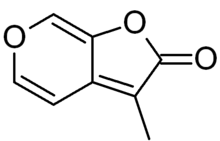Butenolide

The simplest butenolide, 2-furanone.

3-Methyl-2H-furo[2,3-c]pyran-2-one, found in "smokewater"[1]
Butenolides are a class of lactones with a four-carbon heterocyclic ring structure.[2] They are sometimes considered oxidized derivatives of furan. The simplest butenolide is 2-furanone, which is a common component of larger natural products and is sometimes referred to as simply "butenolide". A common biochemically important butenolide is ascorbic acid (vitamin C). Butenolide derivatives known as karrikins are produced by some plants on exposure to high temperatures due to brush fires. In particular, 3-methyl-2H-furo[2,3-c]pyran-2-one was found to trigger seed germination in plants whose reproduction is fire-dependent.[1]
References
- 1 2 Flematti GR, Ghisalberti EL, Dixon KW, Trengove RD (2004). "A compound from smoke that promotes seed germination". Science. 305 (5686): 977. doi:10.1126/science.1099944. PMID 15247439.
- ↑ Joule JA, Mills K. (2000). Heterocyclic Chemistry 4th ed. Blackwell Science Publishing: Oxford, UK
External links
This article is issued from Wikipedia - version of the 5/25/2016. The text is available under the Creative Commons Attribution/Share Alike but additional terms may apply for the media files.